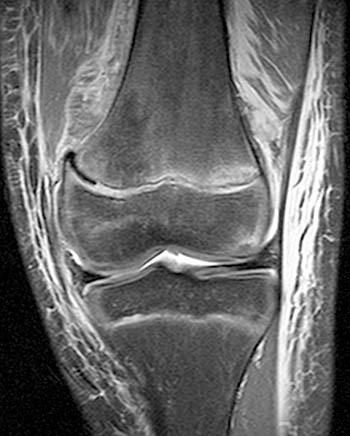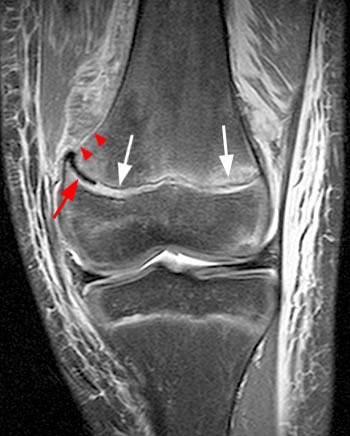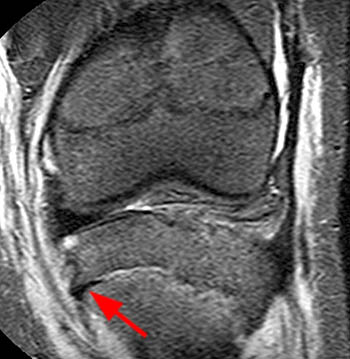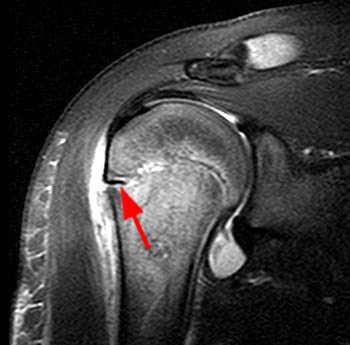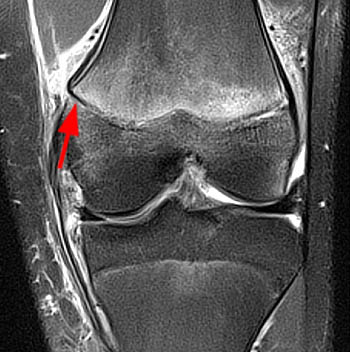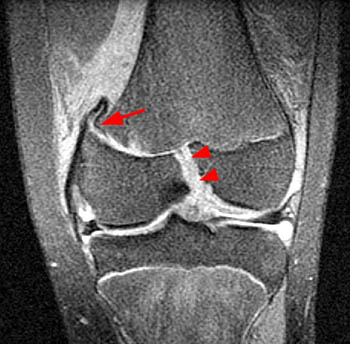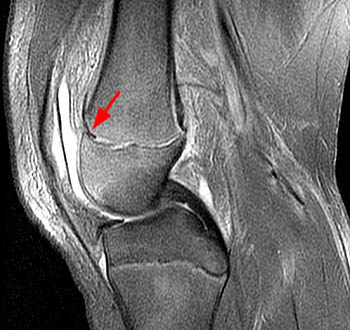Clinical History: A 14 year-old male complains of knee pain after landing awkwardly while playing basketball. A radiograph (not shown) shows mild widening of the medial femoral physis. A fat-suppressed Proton density-weighted coronal image (1a) of the knee is provided. What are the findings? What is your diagnosis?
Findings
Figure 2:
The fat-suppressed proton density-weighted coronal image demonstrates a Salter Harris I fracture of the medial distal femoral physis (arrows) with mild widening and fluid signal at the physis. A linear low signal intensity structure is in the medial physis (red arrow), representing periosteum that has displaced from the medial femoral metaphysis (arrowheads).
Diagnosis
Salter I fracture of the distal femur with trapped periosteum.
Introduction
One of the complications of a physeal fracture is trapped periosteum. If the segment of trapped periosteum is of sufficient size, then adequate fracture reduction cannot be achieved and this in turn can cause premature physeal closure (PPC)1. Most commonly, the fractures are Salter-Harris (SH) I and II types. The most commonly involved sites are the distal femur, proximal2 (3) and distal tibia3, proximal humerus4 (4) and distal radius5, but trapped periosteum can theoretically occur at any physeal site.
If a physeal injury involves fixed or transient widening of the physis and periosteal disruption, the periarticular structures can become entrapped. In the knee, structures that may become entrapped with the periosteum include the medial collateral ligament6 and pes anserinus7. In the proximal humerus, possible structures entrapped with the periosteum include the deltoid muscle and biceps tendon4. In the wrist, entrapment of the pronator quadratus muscle has been reported8. In the ankle, the posterior tibialis tendon has been reported as a periarticular structure that can be entrapped3.
Although PPC is the major concern when structures are entrapped with a physeal fracture, in rare circumstances the entrapment is a surgical emergency. Grace reported anterior tibial neurovascular entrapment in three patients after SH II fractures of the distal tibia. In two of these patients, vascular compromise of the foot occurred which was successfully treated with open reduction and internal fixation9.
Mechanism of Injury
Most SH II fractures are secondary to hyperextension and varus or valgus angular stresses. When the epiphyseal-metaphyseal unit is disrupted, the periosteum is typically stripped from the underlying bony cortex on the distraction side and remains intact on the compression side10 (5, 6). PPC is common at certain anatomic sites and with certain mechanisms of injury. With fractures of the distal tibial physis, PPC after SH I and II fractures occurred less commonly with supination-external-rotation-type injuries (35%) compared to pronation-abduction-type injuries (54%)11.
Imaging Findings
Radiographic Evaluation: Radiography is the mainstay of imaging for physeal injuries. Although the periosteum is not directly visualized with radiography, inadequate reduction can suggest the presence of trapped periosteum. One study concluded that SH I or II fractures of the distal tibia with a residual physeal gap of > 3 mm after closed reduction is considered suggestive of trapped periosteum. A residual physeal gap > 3 mm after closed reduction was associated with PPC in 60% of patients versus 17% when the gap was < 3 mm1.
CT Imaging: CT with multiplanar reconstructions offers improved delineation of osseous structures compared to radiography. Physeal widening and compression and metaphyseal and epiphyseal fractures are better visualized with CT compared to radiography. Additionally, late complications of bony bridging are better seen and quantified with CT compared to radiography. In practice, CT is used selectively for problem solving. Like radiography, CT cannot visualize periosteum.
MR Imaging: MR imaging is used in selected cases of physeal injuries. MR imaging can detect displaced and nondisplaced physeal injuries with greater confidence than radiography (7,8). In a study of pediatric knee examinations for traumatic injuries, MR imaging was superior to radiography in the delineation of the fractures. The diagnosis or confirmation of fractures with MR imaging altered clinical management in seven of eight patients. Additionally, four of these patients had ligamentous and meniscal injuries only seen with MR imaging12.
In addition to visualizing menisci and ligaments, MR imaging allows assessment of articular cartilage and non-ossified epiphyses. MR, like CT, provides multiplanar imaging and is done without ionizing radiation. Other complications such as osteonecrosis and bony bridging can be diagnosed with MR imaging.
In patients where satisfactory reduction cannot be obtained, MR imaging can be used to look for a mechanical cause. A recent report indicates that MR imaging can detect trapped periosteum13. In select situations where satisfactory reduction cannot be obtained, MR imaging can be used not only to detect trapped periosteum but other periarticular structures such as ligaments, neurovascular structures, tendons and muscles can also be evaluated.
Using radiography alone to make treatment decisions means that trapped periosteum will be underdiagnosed. In some patients, trapped periosteum is not associated with physeal widening and therefore will not be diagnosed with radiography. Randomized longitudinal studies would have to be performed to determine the significance of trapped periosteum when no physeal displacement is present.
Treatment
The treatment for trapped periosteum is open reduction and internal fixation. The patients diagnosed with trapped periosteum are those with fractures that cannot be reduced. This cohort of patients likely has relatively large segments of trapped periosteum. Presumably another cohort exists that have smaller entrapped segments of periosteum that go undiagnosed (9). The current indication for treatment is based on reduction as seen on radiography and not the presence or absence of trapped periosteum seen with MR imaging. No randomized trials exist that validate any therapeutic approach to patients with trapped periosteum.
Conclusion
In patients with Salter-Harris I and II fractures that have inadequate closed reduction, MR imaging can be used to diagnose entrapment of periarticular soft tissue structures. Trapped periosteum, in isolation or in combination with other trapped soft tissue structures, can be diagnosed with MR imaging. Open reduction and internal fixation in these circumstances may reduce the incidence of premature physeal closure.
- Barmada A, Gaynor T, Mubarak SJ. Premature physeal closure following distal tibia physeal fractures: a new radiographic predictor. J Pediatr Orthop 2003; 23:733-739. ↩
- Ciszewski WA, Buschmann WR, Rudolph CN. Irreducible fracture of the proximal tibial physis in an adolescent. Orthop Rev 1989; 18:891-893. ↩
- Soulier R, Fallat L. Irreducible Salter Harris Type II Distal Tibial Physeal Fracture Secondary to Interposition of the Posterior Tibial Tendon: A Case Report. Journal of Foot and Ankle surgery 2010; 49:399. ↩
- Ramachandran M, Skaggs D. Physeal Injuries. In: Green N, Swiontkowski M, eds. Skeletal Trauma in Children. Fourth ed. Philadelphia, PA 19103-2899: Elsevier, 2008. ↩
- Lesko PD, Georgis T, Slabaugh P. Irreducible Salter-Harris type II fracture of the distal radial epiphysis. J Pediatr Orthop 1987; 7:719-721. ↩
- McAnally JL, Eberhardt SC, Mlady GW, Fitzpatrick J, Bosch P. Medial collateral ligament tear entrapped within a proximal tibial physeal separation: imaging findings and operative reduction Skeletal Radiology 2008; 37:943-946. ↩
- Thompson GH, Gesler JW. Proximal tibial epiphyseal fracture in an infant. J Pediatr Orthop 1984; 4:114-117. ↩
- Slutsky DJ, Osterman AL. Pediatric distal radius. In: Slutsky DJ, Osterman AL, eds. Fractures and injuries of the distal radius and carpus: the cutting edge. First ed. Philadelphia: Elsevier Health Sciences 2009. ↩
- Grace DL. Irreducible fracture-separations of the distal tibial epiphysis. J Bone Joint Surg Br 1983; 65:160-162. ↩
- Kritsaneepaiboon S, Shah R, Murray MM, Kleinman PK. Posterior periosteal disruption in Salter-Harris Type II fractures of the distal femur: evidence for a hyperextension mechanism. AJR Am J Roentgenol 2009; 193:W540-545. ↩
- Rohmiller MT, Gaynor TP, Pawelek J, Mubarak SJ. Salter-Harris I and II fractures of the distal tibia: does mechanism of injury relate to premature physeal closure? J Pediatr Orthop 2006; 26:322-328. ↩
- Close BJ, Strouse PJ. MR of physeal fractures of the adolescent knee. Pediatr Radiol 2000; 30:756-762. ↩
- Whan A, Breidahl W, Janes G. MRI of trapped periosteum in a proximal tibial physeal injury of a pediatric patient. AJR Am J Roentgenol 2003; 181:1397-1399. ↩

